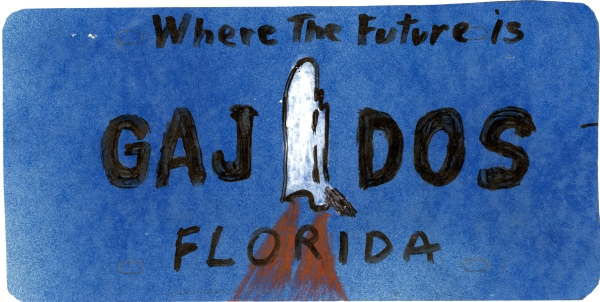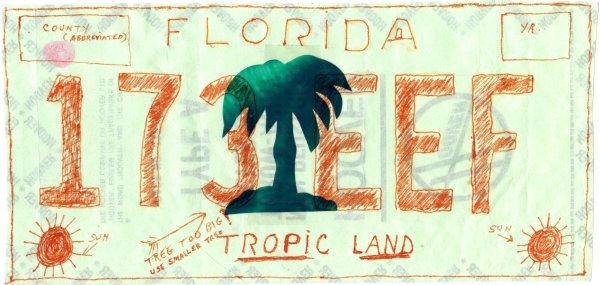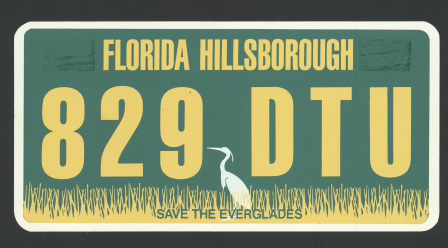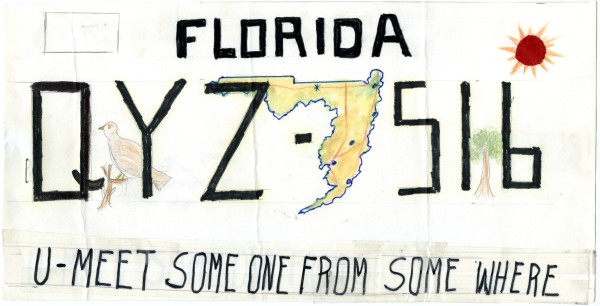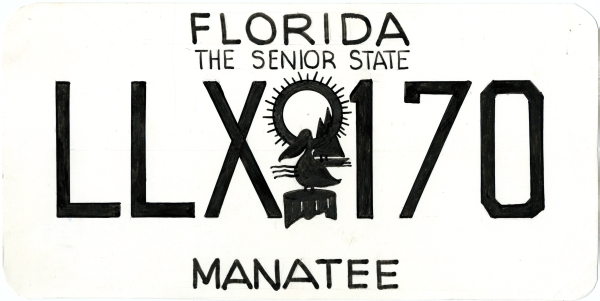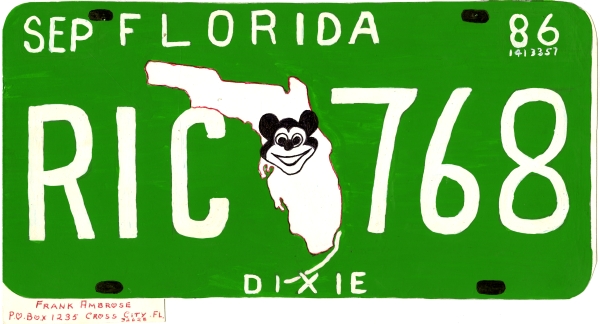Description of previous item
Description of next item
Designing Florida
Published August 8, 2017 by Florida Memory
Sunshine. Swampland. Mouse ears. What images come to mind when you think Florida?
In 1985, Governor Bob Graham, in a quest to redesign the state’s license plate, posed this exact question to Floridians. Earlier that year, the Legislature had enlisted professional graphic designers to create a a new tag, but Graham rejected the proposal. Instead, the governor initiated the Florida license plate drawing contest, calling on his constituency to share their ideas for how to best capture the Sunshine State aesthetic.
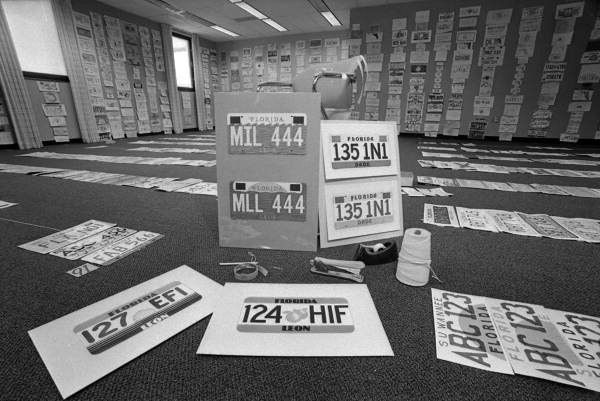
Florida license plate drawing competition entries ready for evaluation, September 25, 1985. Photograph by Deborah Thomas. Since 1905, Florida law has required all registered vehicles to display a license plate.
In an overwhelming display of public participation, the Florida Department of Highway Safety and Motor Vehicles received over 3,500 entries from people of every age, location and talent level. From the environment to tourism, the contest revealed the broad range of interests represented in the state, and especially highlighted the many factors that changed Florida after WWII. The competition also proved the auto tag’s dual purpose as both a vehicle identifier and a powerful marketing tool. As one contestant quipped, the plates acted as “a silent servant” used to “advertise Florida free of charge.”
The State Archives of Florida has since preserved this collection (S1046) of citizen artwork and Florida Memory has recently digitized a small selection. Over 30 years later, the license plate drawings are now a mosaic of how individual Floridians of 1985 visualized their state.
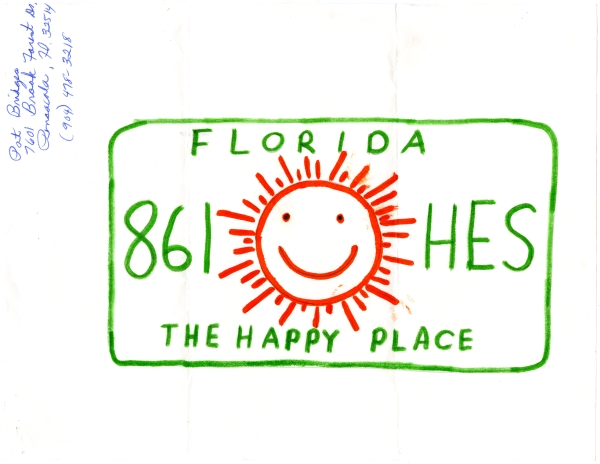
License plate contest entry by Pat Bridges of Pensacola. “My family and I have lived in many different places…and Florida is my favorite of all,” Bridges attested in an attached letter. Click to enlarge.
Contest participants tapped into a wide spectrum of Florida-related imagery, but one of the most popular themes was space exploration.
NASA’s opening of Kennedy Space Center on Brevard County’s Merritt Island in 1962 ignited economic and population growth in the surrounding Space Coast. By 1985, NASA officials had launched numerous successful missions from the central Florida cape, including the moon-landing Apollo 11 in 1969 and Columbia, the first shuttle to orbit in space, in 1981. The space program continued to expand into the 1980s. And many Floridians, like Bela Gajdoes of Winter Haven, a community about an hour and half west of the Kennedy Space Center, saw their home state as the epicenter of outer space innovation.
Whereas some contestants looked to technology for inspiration, many others focused on illustrating Florida’s abundance of plant and animal species.
Perhaps no fruit better represents Florida than a bright waxy orange. Since the 19th century, the citrus industry has remained central to the state’s agricultural economy. The orange has become a common symbol used to market Florida and appeared on several of the plate designs.
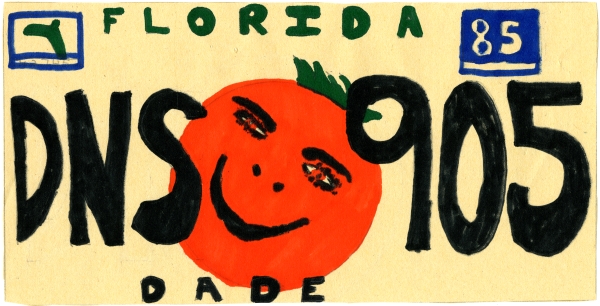
License plate contest entry by 13-year-old Kim Frimowtiz of Pembroke Pines. Lawmakers did not officially designate the orange as Florida’s state fruit until 2005. Click to enlarge.
The sabal palm, Florida’s state tree, also made its way onto hundreds of the tag drawings. “[It is] what I think … best depicts our state to the world,” explained Palm Beach resident W. Stuart Gates, who placed a palm tree silhouette on the center of his tag mock-up.
Though tourists might think only of beaches and palm trees when they imagine Florida’s landscape, natives know all about the dangers lurking just beneath the surface of Florida’s swampland. In a design perhaps too graphic for the interstate, Loman O. Parent of Auburndale, a town near the central Florida Everglades, illustrated this tragic scene of a friend’s encounter with a Florida alligator.
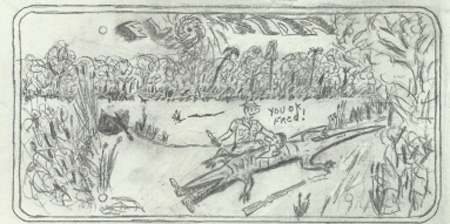
License plate contest entry by Loman O. Parent. It is unclear if Fred made it out of the gator’s belly alive. Click to enlarge.
The Everglades are critical to Florida’s ecology, and environmentalists of the 1980s were concerned about the negative impact of unchecked draining and pollution on the fragile natural resource. The Florida Audubon Society saw the license tag as an effective means of promoting land conservation. They enlisted a professional graphic artist to design this plate emblazoned with a call to “Save the Everglades.”
But those same development techniques that environmentalists opposed, incidentally helped to shape Florida into a desirable place for out-of-staters to move after WWII. Moreover, a sizeable wave of Caribbean immigrants (majority Cuban) fleeing political instability arrived in Florida between 1960 and 1980, further diversifying the populace. In fact, as of 1980 a reported 69 percent of Floridians had been born outside the state, up from 49 percent in pre-WWII 1930.
These demographic shifts likely inspired contestant Harry Gates of Lake City to scrawl “U-MEET-SOMEONE FROM SOMEWHERE,” on the bottom of his plate entry.
Retirees made up a large portion of Florida’s rapidly expanding transplant population in 1985. 75-year-old Richard Allen, who had relocated from New Jersey to Bradenton in the late 1970s, submitted a proposal to change Florida’s nickname to the “Senior State.”
Along with the big increase in new permanent residents after WWII, the opening of Walt Disney World near Orlando in 1971 amplified Florida’s longstanding identity as a major tourist destination. Several proposed license plate designs paid homage to the beloved Mickey Mouse.
After reviewing thousands of entries, state officials narrowed it down to six possible picks and published pictures of them in the newspapers, soliciting public input on selecting the winner.
The Florida Cabinet initially named this stylized drawing of a blazing Florida sun but rescinded their decision after it sparked backlash for its resemblance to the Japanese flag, still a contested symbol 40 years after WWII. “It has a white background with a rising sun in the middle of it. All we need now are Japanese characters on the tag and we can send it to Tokyo,” snarked one Orlando resident.
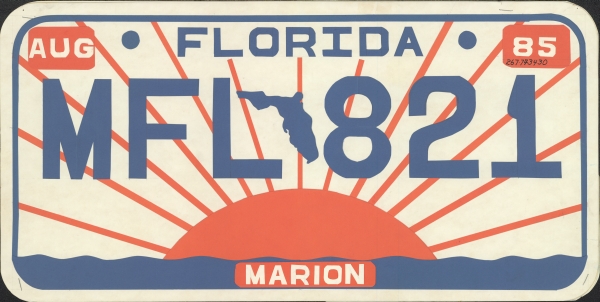
License plate contest entry finalist. Click to enlarge. Note: A note on the back of this plate credits Ocala art teacher Marion F. Lenon as the designer of this plate, but newspaper articles printed this design and credited Hollywood’s Chuck Ax as the artist. It is unclear what the relationship between Lenon and Ax was.
When it came down to choosing a winner of the license plate contest, the Cabinet ultimately chose not to accept any of the contest drawings. In an anticlimactic turn of events, they decided to simply invert the colors of the existing plate and add two orange blossoms. That same tag design is still used today.
However, the Florida Legislature remains aware of Floridians’ many interests and has approved over 100 specialty plates since 1999.
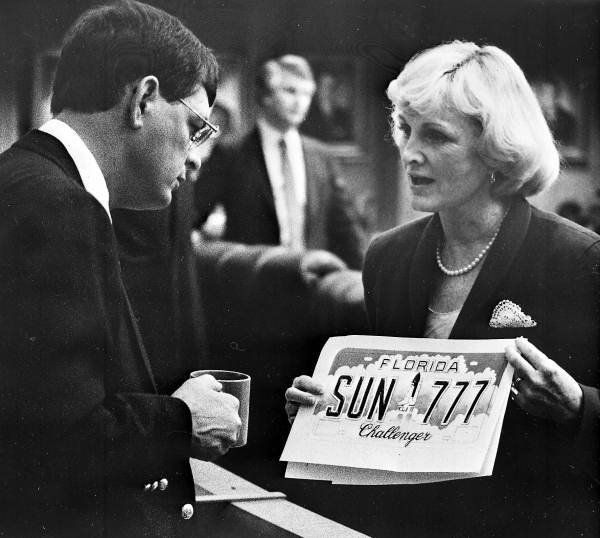
Rep. Fran Carlton (D-Orlando) lobbying Rep. Dale Patchett (R-Vero Beach) to pass the Space Shuttle Challenger license plate bill, 1986. The bill did not pass until 1999, when it became the first of Florida’s specialty plates.
Did you participate in the 1985 Florida license plate drawing contest? Try searching Florida Memory to see if your design is one of the ones we've digitized. You can also view the complete collection of contest entries in person at the State Archives in Tallahassee.
Cite This Article
Chicago Manual of Style
(17th Edition)Florida Memory. "Designing Florida." Floridiana, 2017. https://www.floridamemory.com/items/show/332813.
MLA
(9th Edition)Florida Memory. "Designing Florida." Floridiana, 2017, https://www.floridamemory.com/items/show/332813. Accessed December 17, 2025.
APA
(7th Edition)Florida Memory. (2017, August 8). Designing Florida. Floridiana. Retrieved from https://www.floridamemory.com/items/show/332813

 Listen: The Assorted Selections Program
Listen: The Assorted Selections Program